In March 1985 I arrived in Karl-Marx-Stadt (Chemnitz), where I had to take a language course. By July or August, I had completed it and went to Dresden University of Technology (TU) for a diploma programme in electrical engineering.
I already had a bachelor’s degree in electrical engineering at that point.
I started my post-graduate degree course in the GDR at TU Dresden in September 1985. It was called a diploma programme, not a master’s programme, and normally took five years, but I only had to complete half of it as my bachelor’s degree was recognised. I studied in the electrical engineering department.
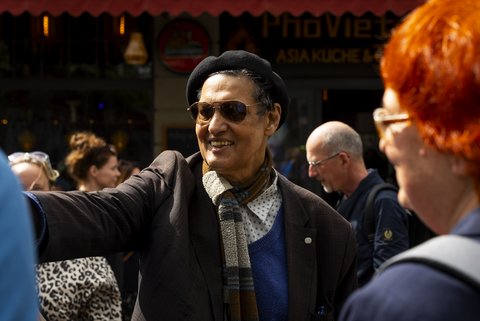
Stadtrundgang “Die Neustadt zwischen Hanoi und Havanna” mit Hung Cao The, Bui Truong Binh und Dr. Hussein Jinah
© Staatliche Kunstsammlungen Dresden, Foto: Nora Börding
In 1986, chance brought me together with the woman I fell in love with. A friend of mine was supposed to be meeting up with her, but he couldn’t go, and I went in his place. I was 26 years old, and she fell in love with me instantly. I think part of the attraction was that I came from a country that was capitalist but also had ties to socialism.
The merit-based scholarship I was awarded then was worth first 340 and later 300 marks. There were five of us in the exchange programme. East German postgrads went to India to take Indology and Indian languages, culture and cultural studies.
The five of us came to the GDR to study electrical engineering, chemistry and process engineering, and were sent to various higher education institutions.
I got my diploma in 1987 and moved straight on to a doctoral thesis in electrical engineering. After reunification, in 1991, my doctoral thesis was also recognised in West Germany. It was an international thesis, started in the GDR and completed in the Federal Republic. When I had finished my doctoral thesis, I moved on to a lecturing qualification, but the university let me go after a month as only public employees with German citizenship were allowed to get a lecturing qualification. My Indian citizenship was not accepted. According to Frederick the Great’s 1913 Nationality Act, you had to have lived in Germany for 15 years to become German. The law was passed with the Huguenots in mind and was still in place back then.
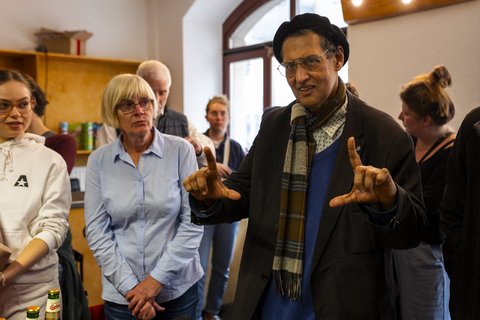
Stadtrundgang “Die Neustadt zwischen Hanoi und Havanna” mit Hung Cao The, Bui Truong Binh und Dr. Hussein Jinah
© Staatliche Kunstsammlungen Dresden, Foto: Nora Börding
I wanted to go back to become a professor, but my wife didn’t want to move to India. So it was love that kept me here. We came to a compromise. I stayed. I sent out more than 100 applications for jobs as an electrical engineer in West Germany and Austria. Some people didn’t answer; some said I was overqualified, or that they were not taking on new workers due to restructuring; many people went to the West after reunification, and all our institutes closed down. I got a permanent residence permit for Germany as I had already been living here for 5 years. People who had been here that long could be “useful”, as lots of people migrated from the East to the West between the fall of the Wall and reunification.
In 1992, I then got a job as a social worker at Wienerstraße 41, once the headquarters of the GDR youth movement, the FDJ. The building was repurposed and became an advice centre for young foreign nationals. The director put in a good word for me and I got the job. From 1994 to 1997, I studied social pedagogy at TU Dresden while working and, at the same time, gained a diploma in psychology.
My job as a social worker involved visiting migrants all over Dresden to offer them support. I did that until 1999, then the field of youth work was comprehensively restructured. The work I had done was no longer one of our duties, and it was passed on to independent providers. A mixture of office work and street-based work then developed. We formed a small group, responsible for a catchment area comprising the Johannstadt, Altstadt and Neustadt districts, and cooperated with independent youth welfare organisations such as “Outlaw" and "Roter Baum". From 1999 to 2009, that street-based work was run by Dresden City Administration. In 2010, the City Administration decided to hand over full responsibility to independent providers.
Someone suggested that I should switch to managing the staff council, so I was released from my duties and started working at the city hall. The others went into general social services, while I – a person with a history of migration – was responsible for 5,000–6,000 members of staff. My experience helped me offer people good advice. I also worked as a visiting professor of diversity management in Merseburg, running seminars for various students in the fields of sociology and psychology. At the university and as a public servant, my skills were extremely important when it came to supporting both homogeneous and heterogeneous administrative structures.
After working at the city hall, I switched to the new migration department at the social welfare office. I was the first social worker there to only be responsible for migrants (mostly refugees). I worked there for three years before getting a position at the Mayor’s office, where I was put in charge of commemorative practices, the board of directors and co-organising events.
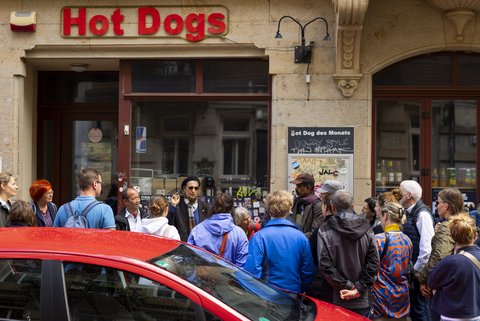
Stadtrundgang “Die Neustadt zwischen Hanoi und Havanna” mit Hung Cao The, Bui Truong Binh und Dr. Hussein Jinah
© Staatliche Kunstsammlungen Dresden, Foto: Nora Börding
I also volunteer. I work for the “Indian Association of Dresden e. V.” and am on the board of Afropa e. V. I have chaired the ver.di migration committee for Saxony, Saxony-Anhalt and Thuringia, the board of directors of the Saxon Refugee Council and the City of Dresden’s Office for Integration and Foreign Citizens’ Affairs. I also have side jobs in a late-night shop and as a community interpreter, and have waited tables. You might call me a Jack of all trades.
My overriding aim is to promote peace, cohesion and non-violence in society.
For the walking tour of the Neustadt district entitled “The Neustadt, from Hanoi to Havana”, I invited participants into the late-night shop where I work and told them my story. I also wrote a book about my life in association with Nikola Richter from Berlin.
My father went to Tanzania to take over my grandfather’s business during the British colonial period. We ran a colonial goods shop there selling pencils, jewellery and fabrics. In India, marriage for love had not been very common up to then. My father moved there in 1957 having seen a photograph of the primary school teacher who would become my mother. On his arrival, he married her in the British colonial territory. In July 1958, we moved back to Tanzania as a family, travelling from India on a British steamer. It dropped anchor 20 km off the coast near Dar es Salaam. My mother was heavily pregnant.
I was born on the steamer not far from Mafia Island on 20 July, the day Stauffenberg attempted to assassinate Hitler in 1944 and the day of the first moon landing in 1969. The British midwife and the doctor did their best to assist with my birth, though the sickbay was not really designed for that kind of case. The navy was radioed to come and get us. Queen Elizabeth was told the news and became my godmother, as I was the first baby born in British maritime territory.
I was a citizen of the world who felt at home in Saxony. My socialisation was shaped first by Anglo-German, then by German influences. Three years after my birth, Tanzania gained its independence. Zanzibar, ruled by Omani sultans, merged with the mainland in 1964 to form the United Republic of Tanzania.
This followed a socialist course that affected my father’s business.
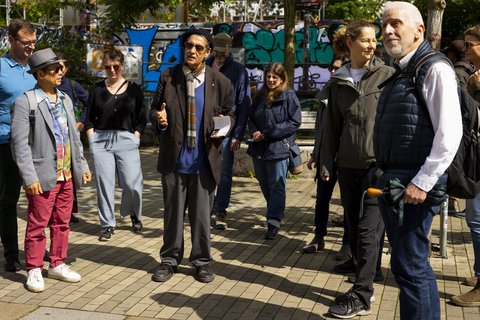
Stadtrundgang “Die Neustadt zwischen Hanoi und Havanna” mit Hung Cao The, Bui Truong Binh und Dr. Hussein Jinah
© Staatliche Kunstsammlungen Dresden, Foto: Nora Börding
We moved to South Africa, where we experienced apartheid. We did not like the severe discrimination. I myself experienced racism such as being segregated on a train that was only for whites, which made me cry. Eventually, we returned to India, where I had to do mandatory military service after getting my higher secondary school certificate. I took part in a peace mission in Tanzania, guarding a large camp for refugees fleeing the apartheid system.
Most came from Mozambique and Angola. My job was to protect the refugees. People with other nationalities were involved in the mission, too. I discovered that if you open yourself up to others without prejudice, you can learn a great deal. Our diversity enriches us, and if we were all the same, it would be boring.
When I returned to India after military service, I wanted to become an actor. In about 1977/78, I played an amateur part in a Bollywood film (though it was not called that at the time). The film was good, but flopped. There’s no material from it any more as it was shot on 32 mm film. We didn’t see any money, either, and it was not well received by audiences. In the story, two students – a Muslim and a Hindu – both from very conservative families, go to college. Their families oppose their relationship, so they meet in secret. They decide to run away together and marry in a temple. The film ends with their parents calling the police to report the couple missing. They move far from their conservative surroundings to start a new life in a place where their children can decide for themselves what they want to do. The film drew a lot of criticism from highly conservative members of society, and because of the caste system. Bollywood later refilmed the tale.
I did not have any relationship with art in the GDR. It was not possible to work with full artistic freedom there, as art was not freely accessible to all. Art, industry and politics were strictly separated. In GDR times, we had an Indian association that involved making music and dancing. Art institutions were not accessible to the general public, and were under surveillance.
In 2014 I took a role in a play at the Kleines Haus theatre and spent a year and a half with the Bürgerbühne amateur theatre club acting in a version of “The Wanderings of Odysseus” by Miriam Tscholl and Hajo Kurzenberger. The script told our stories, described refugeeism and migration.
I went on to do street theatre with the Afropa e. V. association and acted in “Misere Europa” at Theaterhaus Rudi for a year alongside Andrea Rump. In another play, “Dinnor on se Bood”, under the Syrian director Anis Hamdoun, I represented India and Pakistan. That story, too, was about the wide range of migration histories found in East Germany, and experiences of racism.
I was one of the first to demonstrate against Pegida. The police asked me what I was doing there. To me, it was about nipping things in the bud. Back then, they thought it was a fringe movement. The couple of hundred people from the start have now turned into tens of thousands who have been radicalised.
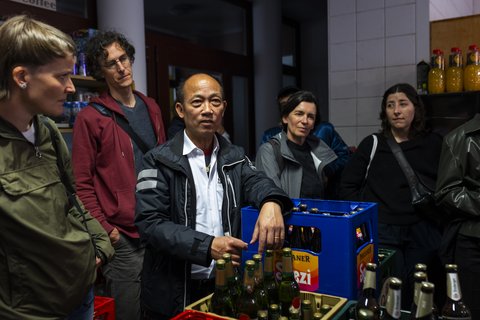
Stadtrundgang “Die Neustadt zwischen Hanoi und Havanna” mit Hung Cao The, Bui Truong Binh und Dr. Hussein Jinah
© Staatliche Kunstsammlungen Dresden, Foto: Nora Börding
Yes, democracy means accepting freedom of speech and other people’s opinions, but it has its limits, too. Democracy is always controversial allows us to argue. One reason it exists is to avert danger, and populist right-wing extremist parties like this pose a danger to our democratic community.
Anything polarising, that involves extremes, is a threat to that community’s stability.
Looking back at the GDR, the solidarity there was about people having the same world-views. But solidarity should actually develop between people of any world-view. It helps people in need whatever their origins, skin colour or religion. Rather like democracy, it comes up against its limits when it becomes a threat to society and heralds danger and violence.
Looking at the election results, I wonder where we went wrong. Equality for all clearly does not rule out discrimination and division.
Unity, rationality and a willingness to reconcile are important.
Rather than asking myself how much money I’ve made or how successful I’ve been, I try to ask what I have done for the community.

Keep Reading
With the “Ortsgespräche” series, the Schenkung Sammlung Hoffmann is making itself available for art locations in the so-called rural areas of Saxony, where the diversity and social relevance of contemporary art is sometimes discussed with particular vehemence. The Hoffmann Collection has cooperated with the rural village Prösitz and the female artists working on the Künstlergut (artist's estate) Prösitz, where they produced thought-provoking art concerned with the A14 freeway that dominates the local resident's day-to-day lives.
![KilligBild [Translate to English:]](/fileadmin/_processed_/9/8/csm_040624killig001_e048c2ccda.jpg)
The "ostZONE" series, part of the special exhibition "Revolutionary Romances? Global Art Histories in the GDR", created a space within the Albertinum for anyone to share conversations, questions, and memories of life in the GDR and in modern-day eastern Germany. Read about Hung The Cao and his workshop with contemporaries "Jeans nach Dienstschluss" ("Jeans after Hours").
![[Translate to English:]](/fileadmin/_processed_/e/2/csm_20231111-WorkshopSKD-_c_IonaDutz-0142_5578f50488.jpg)
The "ostZONE" series, part of the special exhibition "Revolutionary Romances? Global Art Histories in the GDR", created a space within the Albertinum for anyone to share conversations, questions, and memories of life in the GDR and in modern-day eastern Germany. Bela Álvarez organized the "Holding the Strings" ("Die Fäden in der Hand halten") workshop, bringing the power of images as well as the power of our hands into focus.
![[Translate to English:]](/fileadmin/_processed_/5/c/csm_20240726_bela_02_685000bde4.jpg)